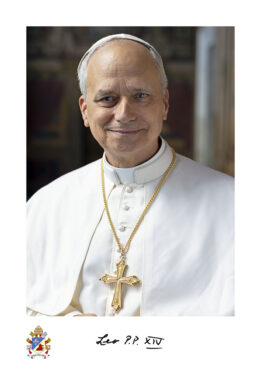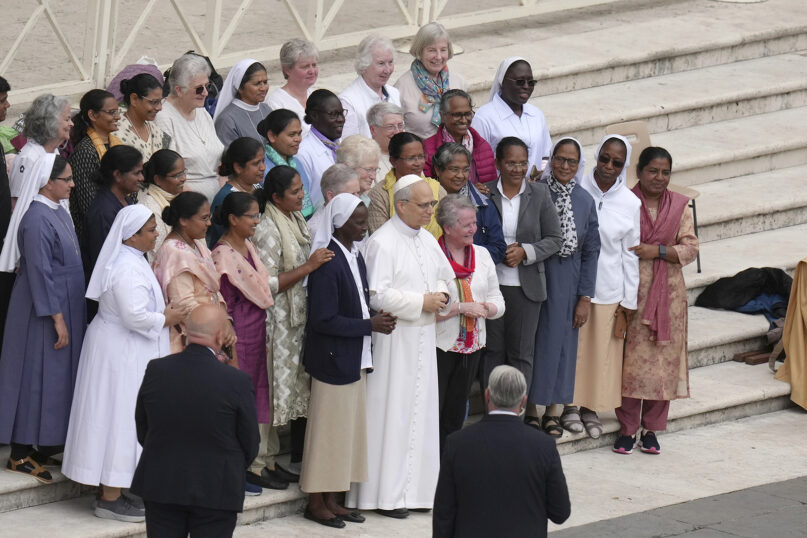VATICAN CITY (RNS) — In two wide-ranging interviews with Crux Vatican reporter Elise Ann Allen, Pope Leo XIV addressed some of the most pressing questions facing his pontificate and the Catholic Church, including the wars in Gaza and Ukraine, the welcoming of LGBTQ people in the church and how he plans to address the Trump presidency in his native United Sates.
What emerged from the interviews is a portrait of a pope who is cautious and favors listening, while still willing to draw a firm line on doctrine and priorities. “I am not trying to continue promoting polarization in the Church” is a phrase he repeats often and in different contexts, befitting the ancient Latin papal moniker pontifex: bridge-builder.
Leo XIV is not naive about the Holy See’s limited power to intervene, especially in war, nor does he undersell the acute difficulties of the church’s finances or its internal divisions. He offers as an antidote a true missionary spirit, honed in his many years ministering in Peru, coupled with Pope Francis’ appeal to build a poor church for the poor.
“I don’t see my main role as trying to be the problem-solver of the world,” Leo told Crux, “although I do believe the Church has a voice, a message that needs to continue to be preached, to be spoken and spoken loudly.”
So far, the silent and smiling pope has been like a Rorschach test, a blurry image where anyone can see or imagine whatever they hope in this new pontificate. But these first interviews offer a premiere look behind the veil and a glimpse into what Pope Leo XIV is really about.
Excerpts from the interviews were first published on Sept. 14 on the Catholic news site Crux. The full interviews are available in Spanish in Allen’s new book, “Leo XIV: Citizen of the World, Missionary of the XXI Century,” which will be published in English and Portuguese in 2026.
On the U.S. bishops: Under Francis, the Vatican relationship with U.S. bishops was often described as tense. Leo, who was born and raised in Chicago, made clear in his interview that he expects fewer misunderstandings. “The fact that I’m American means, among other things, that people can’t say, as they did with Francis, ‘he doesn’t understand the United States, he just doesn’t see what’s happening,’” Leo said, showing that he is keenly aware of the issues that existed in the past. As the former head of the Vatican department overseeing bishops, Leo also has insider knowledge of the American bishops’ priorities and concerns.
The pope said he would speak to the bishops directly and pointed to Francis’ letter, sent in late February encouraging the U.S. episcopate to advocate for migrants and refugees.

On President Donald Trump: The pope stressed that he has no intention of being sucked into partisan politics and will leave it to bishops to engage with the Trump administration, but said, “I’m not afraid to raise issues that I believe are true issues of the Gospel, which I hope people on both sides of the aisle, as we say, can hear.”
It’s up to the U.S. bishops, Leo said, to engage with the Trump presidency “very seriously.” While he noted that some of the things that are happening in the United States “are a cause of concern,” Leo also said that he is willing to work with Trump “especially on questions of human dignity, of promoting peace in the world.”
Gaza and Israel: Addressing the violence and war in Gaza, Leo voiced concern for the lack of effective solutions to help innocent civilians. He recognized that the lasting effects of famine, especially for young people, cannot be quickly resolved by delivering aid, but require medical attention and rehabilitation.
“It’s so horrible to see the images on television, I wish something would change this situation,” he said, adding that he hopes the world will not become desensitized by the sight of so much pain. As Christians, he added, people have a responsibility to continue working to bring about change in the region.
Leo recognized that the term “genocide” is being used “more and more” about the civilian deaths in Gaza, but he said the Holy See cannot make an official statement until the status is determined by the international community. Acknowledging that a growing number of human rights groups and individual are raising the issue, he said, “there is a very technical definition of what a genocide might be.”
This position is aligned with Francis, who in 2024 deferred the question to an international inquiry about whether the term “genocide” can be used to describe the plight of the Palestinian people.
But Leo called rekindling relations with the Jewish community a priority, saying that they have already “improved a little” in the first months of his pontificate. “It is important to make some distinctions that they themselves make between what the Government of Israel is doing and who the members of the Jewish community are,” he said.
Women deacons: Leo confirmed his intention to promote women leaders in the church but drew a clear line at the ordination of women to the diaconate, a question that had been raised at recent summits of bishops at the Vatican. Deacons can preach from the pulpit and perform some sacraments but can’t celebrate the Eucharist, hear confessions or anoint the sick.
“I think it will continue to be a problem. I, for the moment, do not intend to change the teaching of the Church on the matter. I think there are some previous questions that need to be asked,” he said.

Echoing his immediate predecessors, Leo framed women’s ordination as a question of clericalism — it risks treating members of the clergy, male or female, as more important than lay Catholics. He said that before women could occupy the role of deacon, the church would need to establish in church culture a better understanding of the permanent diaconate — as opposed to a way station before priesthood, as it currently is in the church.
LGBTQ+ inclusion: Leo used the interview to put himself in line with Francis’ call that the church be open to all Catholics, while not budging on doctrine. “I think we have to change attitudes, before even thinking about changing what the Church says about any given question,” he said. “It seems very unlikely to me, certainly in the near future, that the Church’s doctrine will change in terms of what it teaches about sexuality and marriage.”
Families, he said, are made up of a man, a woman and children. He pushed back against those who said the Vatican’s 2023 doctrinal document on the blessing of people with same-sex attractions, “Fiducia Supplicans” (Supplicating Trust), was tantamount to blessing gay couples’ relationships. “The teaching of the Church will continue as it is, and that is what I have to say about it for now,” he said.
China: Catholic conservatives were disturbed by Francis’ signing of a 2018 agreement between China and the Holy See. While the document’s content remains secret, it has been described as allowing Beijing to have a significant say in the appointment of bishops, normally the prerogative of the pope.
Leo said that for the short term he plans on observing the agreement as is but that he has already had conversations with members of the officially recognized church in China and of the so-called underground church that operates illegally in the country with recognition from Rome.
Latin Mass: Conservatives widely resent the restrictions placed by Francis on the Old Rite, known as the Tridentine Mass, in his 2021 apostolic letter “Traditiones Custodes” (Guardians of the Tradition). Leo said he has already received many requests on the issue since becoming pope, and he said the issue is “very complicated.”
Leo blames polarization in the church for the tensions surrounding liturgy, adding that the Tridentine Mass has become for some “a political tool.” He recognized that the “abuse” of the liturgy after the Second Vatican Council, which sought to reconcile the church with the society of the 1960s, may have left some seeking “a deeper experience of prayer, of contact with the mystery of faith.”
But the pope said those who advocate for the Tridentine Rite have refused to engage in dialogue with the Vatican on this issue. “It means that we are now in ideology, we are no longer in the experience of the communion of the Church,” he said, adding that the topic is being studied by a group of experts and theologians at the Vatican.
Building a better church: Francis ushered in a wave of reform of the Roman curia, the Vatican bureaucracy. Leo said he plans to continue the reform effort enshrined in the 2022 apostolic constitution “Praedicate Evangelium” (Preach the Gospel) and will also make some changes.
Among them is promoting better systems of communications among the Vatican departments, which often work as monoliths with rare instances of collaboration. He claimed that the Vatican’s famously troubled finances are not as bad as some have stated, adding that “it doesn’t keep me up at night.”

In his papacy, Francis increasingly emphasized synodality, an approach to church governance based in dialogue, inclusion and the promotion of laypeople in the church. Leo supports the concept, telling Crux, “A leader who walks alone is not leading anyone, but if a leader is capable of bringing people together and moving forward together, that is much more effective.”
A better church for Leo also includes outreach to other denominations. He intends to invite many leaders of religions and Christian denomination to meet him in Nicaea, Turkey, in late November, where he will mark the 1700th anniversary of the Council of Nicaea and the formulation of the Nicene Creed.
He also said he plans to build bridges with the Orthodox Church in Russia, with the hope of promoting dialogue between the Patriarch of Constantinople and the Patriarch of Moscow, who have been at odds in light of the war in Ukraine and friction within the Orthodox faiths. Leo said “some steps” have been taken toward finding a common date for Easter among all Christian denominations.
Clergy sexual abuse: The pope said the church’s abuse crisis is one of the main concerns of his papacy. He is pushing for faster trials while preserving the presumption of innocence for accused priests. Most of all, he vowed that victims and survivors would be heard and treated with respect and dignity.
Artificial intelligence: In his short tenure, Leo has already discussed artificial intelligence several times and it promises to be a matter of great interest in his pontificate. He advocates for caution about the technology’s rapid development and offered the church’s long history of considering the human condition to the world’s discussion about its limits and uses.
“The Church is not against the advances of technology, at all, but losing the relationship between faith and scientific reason, I think leaves science as an empty, cold shell, that will do great harm to humanity,” he said.
He also spoke about AI’s role in advancing fake news and conspiracy theories. “There is a truth, authentic truth,” that cannot be bent to alternative visions or perspectives, he told Crux. On the other hand, Leo said, are AI-generated videos that show him falling, and those asking to create an AI avatar of Leo that can offer spiritual answers. “If there’s anyone who shouldn’t be represented by an avatar, it seems to me, it’s the pope,” he said.
Throughout the interview, Leo described himself as charged with the main purpose of guiding the attention of the lost and lonely humanity toward God and the heavens. He said that as the church celebrates the Jubilee of Hope this year, he finds himself “full of hope” despite the challenges, “because that is really what the Church represents, we have so much to offer the world.”
Original Source: